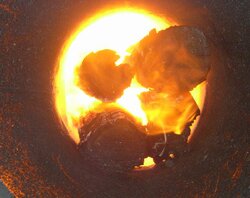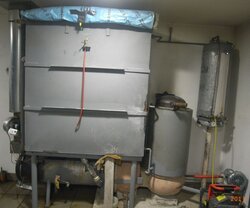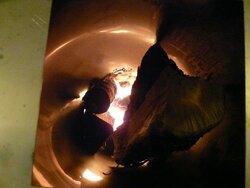Snail
Member
Hey, you got it going! Fantaastic! My congratulations.
It may not be necessary to further modify the heat exchanger itself. Probably all you need to do would be to put an extension of one of the pipes inside the tank to near the top. (It doesn't need to be completely "waterproof") If that doesn't work you won't have lost anything, since it is a halfway step on the approach that you have suggested.
It's best to lengthen the pipe from the hot end of the exchanger. This will make a counter-flow exchanger, which is much more efficient than the reverse.
How are you making the turbulators? The pdf of Dr Hill's paper doesn't say what his final design was, only that wire bottle-brushes worked but weren't durable. Not too surprising in an oxygen-rich flame.
I used to work with a guy who did his time on KA steam locomotives. Pity he is not still around, what a goldmine of info he would be. His stories were amazing. He was a big bloke and he still remembered the pain of crawling through a hot firebox to get at the fire tubes. Those old locos were amazing to see, they were still the mainline passenger express hauler when I was a young man, but the boilers had to be practically re-built after not too many round-trips between Wellington and Auckland. To minimise down-time, fire-tube replacement began the instant the firebox was dumped. Ouch!
I don't know anything about wood-furnace technology, but I imagine that here too the fire-tubes must burn out eventually. That would be end-of-life for this design. Anyone have any info about longevity of the tubes in this environment?
It may not be necessary to further modify the heat exchanger itself. Probably all you need to do would be to put an extension of one of the pipes inside the tank to near the top. (It doesn't need to be completely "waterproof") If that doesn't work you won't have lost anything, since it is a halfway step on the approach that you have suggested.
It's best to lengthen the pipe from the hot end of the exchanger. This will make a counter-flow exchanger, which is much more efficient than the reverse.
How are you making the turbulators? The pdf of Dr Hill's paper doesn't say what his final design was, only that wire bottle-brushes worked but weren't durable. Not too surprising in an oxygen-rich flame.
I used to work with a guy who did his time on KA steam locomotives. Pity he is not still around, what a goldmine of info he would be. His stories were amazing. He was a big bloke and he still remembered the pain of crawling through a hot firebox to get at the fire tubes. Those old locos were amazing to see, they were still the mainline passenger express hauler when I was a young man, but the boilers had to be practically re-built after not too many round-trips between Wellington and Auckland. To minimise down-time, fire-tube replacement began the instant the firebox was dumped. Ouch!
I don't know anything about wood-furnace technology, but I imagine that here too the fire-tubes must burn out eventually. That would be end-of-life for this design. Anyone have any info about longevity of the tubes in this environment?





 , that baby burned with some intensity
, that baby burned with some intensity